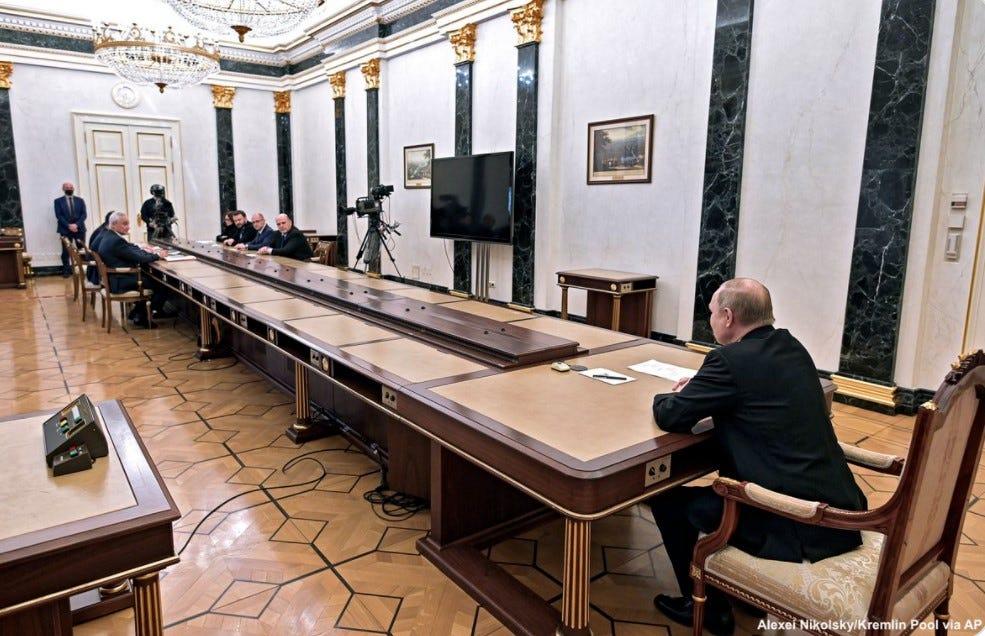
There are photos that once seen, will haunt one’s soul in the context of this genocidal Russian invasion of Ukraine.
The first was Russian dictator Vladimir Putin “meeting” with the ministers of his government. Putin sits at one end of a very long table; his minister clustered at the other end, 40 feet away. This is a leader detached from reality, his 190,000 invasion force bogged down, with cruise missiles and cluster bombs strafing an array of civilian targets.
Another is of U.S. Rep. Victoria Spartz laying a wreath at the base of the Babyn Yar Holocaust Memorial in Kyiv when she visited the doomed capital in late January. On Tuesday, a Russian missile hit a nearby TV tower, killing at least five people. NBC News showed footage of emergency officials using fire extinguishers to tamp the flames on smoldering corpses.
“To the world: what is the point of saying ‘never again’ for 80 years, if the world stays silent when a bomb drops on the same site of Babyn Yar? At least 5 killed. History repeating…,” Ukraine President Volodymyr Zelensky wrote in a tweet.
This prompted Spartz to say of her native country, “This is not a war. This is genocide of the Ukrainian people by a crazy man who cannot get over that the Ukrainian people do not want socialism, Soviet Union, or Communists. They want to be free people. They want to be with the West.”
On Twitter, there were photos of anti-tank hedgehogs outside the Odessa Opera Theatre taken during the Nazi invasion in 1941, and again this past week. This is history repeating with Russia’s fleet ominously appearing on the horizon.
Traveling to Moscow and Odessa with Sen. Richard Lugar in 2007, I remember passing three huge hedgehog sculptures in the Russian capital, the Monument to the Defenders of Moscow, marking the eastern most advance of the Wehrmacht during World War II, a conflict that claimed more than 20 million Russian and Ukrainian lives.
The Odessa National Academic Opera and Ballet Theatre is a beautiful building situated on a boulevard not far from the Potempkin Stairs that present 192 steps from the wharves to this beautiful Black Sea city. I remember when we left at dawn, dozens of shop keepers were brooming the sidewalks in a normal display of civic pride.
In 1941 with the Romanian army bearing down on the city, defenders surrounded the opera house with anti-aircraft guns. When the siege lifted after 71 days, Commissar Nikita Khrushchev immediately returned to this liberated city, reporting that only one corner of the opera house had been damaged.
It’s ironic that Khruschev is mentioned here. In 1962, this Ukraine native’s decision to try to install nuclear weapons 90 miles from the United States set off the Cuban Missile Crisis, the most harrowing 13-day period of the nuclear age. It ended when President John F. Kennedy resorted to a blockade before the Soviet leader backed down. “Bombs do not choose. They will hit everything,” Khrushchev said. “The more bombers, the less doves of peace.”
Putin’s move has, after a week, looked to be an evolving disaster. His army has bogged down, losing some 4,000 soldiers in a week (the U.S. lost 4,431 soldiers in Iraq and 2,401 in Afghanistan). He may be forced to withdraw, or resort to tactical battlefield nukes or indiscriminate genocide waged against urban populations in Kyiv and other cities. Putin has to be growing nervous as Russian citizens continue to protest in the streets, forging long lines at collapsing banks and empty ATMs. The feeble Russian economy is cratering, with people taking to the streets in protest, at great peril to themselves.
There has been quiet talk that Putin’s invasion could backfire in Shakespearean fashion, with Russian people convincing the military to do what it did to Mikhail Gorbachev in 1991, which was to remove him from power. While this remains the longest of long shots, since Donald Trump’s historic upset in 2016, the mantra here has been “anything can happen.” The next three months could be stunning.
On Sunday, Putin put his nuclear forces on high alert. “Top officials in leading NATO countries have allowed themselves to make aggressive comments about our country, therefore I hereby order the minister of Defense and the chief of the General Staff [of the RF Armed Forces] to place the Russian Army Deterrence Force on combat alert,” Putin said in televised meeting with his generals.
Are we about to enter a period of the first nuclear brinksmanship of the 21st Century? U.S. Sen. Angus King observed of Putin, “Right now he’s the most dangerous man in the world.”
Appearing beside Spartz on Wednesday, U.S. Sen. Lindsey Graham dismissed Trump’s description of Putin as a “savvy genius” for putting “peacekeepers” in Ukraine. With the whole world watching, we’ve seen photos of dead Ukrainian children, bombed out apartment buildings, a million refugees, and video of a Russian tank swerving to crush a subcompact car. “It’s political malpractice not to get our crap together,” Graham said. “Putin’s not a genius. He’s a war criminal.”
The problem facing Western leaders is, what will the “delusional” Putin (as former secretary of state Condoleezza Rice described him last Sunday) do if his back is against the wall?
Nikita Khrushchev once said, “If you live among wolves, you must act like a wolf.”
The columnist is publisher of Howey Politics Indiana at www.howeypolitics.com. Find Howey on Facebook and Twitter @hwypol.
This article originally appeared on South Bend Tribune: Photos of this genocidal Russian invasion of Ukraine are haunting.




